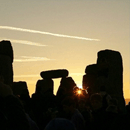Archaeologists find huge Neolithic village near Stonehenge
AFP
Mon January 29, 2007
Area: Wiltshire
Archaeologists at the University of Sheffield have unearthed a huge settlement at Durrington Walls, near Stonehenge, confirming that the Stonehenge monument was part of a larger ritual centre.
The excavations reveal an enormous ancient settlement that once housed hundreds of people. Archaeologists believe the houses were constructed and occupied by the builders of nearby Stonehenge, the legendary monument on Salisbury Plain.
Radiocarbon dated to 2600-2500 BC, the houses are from the same period Stonehenge was built - one of the facts that leads the archaeologists to conclude that the people who lived in the Durrington Walls houses were responsible for constructing Stonehenge. The houses form the largest Neolithic or new stone age village ever found in Britain.
Eight of the houses' remains were excavated in the Stonehenge Riverside Project, led by Professor Mike Parker Pearson from the University of Sheffield and five other archaeologists from the UK.
"Durrington's purpose was to celebrate life and deposit the dead in the river for transport to the afterlife, while Stonehenge was a memorial and even final resting place for some of the dead," explained Professor Parker Pearson. "Stonehenge's avenue, discovered in the 18th century, is aligned on the midsummer solstice sunrise, while the Durrington avenue lines up with midsummer solstice sunset."
The floors of six of the houses were found well-preserved and archaeologists believe each house once measured about 5 metres square and had a clay floor and central hearth. The team found 4,600-year-old debris strewn across floors, postholes and slots, which once anchored wooden furniture that had disintegrated long ago.
Among the debris were piles of animal bones, which may also suggest the Neolithic village was also the place to go for a lavish feast, featuring spit-roast pork and beef. Elsewhere the team found the imprints of beds and other furniture still present on the clay floors.
More houses are clustered on both sides of an imposing stone-surfaced avenue some 30 metres wide and 170 metres long, found in 2005 and further excavated by the team in 2006. The avenue connects remains of a colossal timber circle with the River Avon.
Existence of the avenue, which mirrors one at nearby Stonehenge, indicates people once moved between the two monuments via the river. Discovery of the avenue has helped the team piece together the purpose of the entire Stonehenge complex.
"This discovery at Durrington Walls sheds light on the actual purpose of Stonehenge and shows that it wasn't a monument in isolation but part of a larger complex," added Professor Parker Pearson.
"It is vital in our understanding of Stonehenge and paves the way for further investigation at the site in the summer and hopefully more remarkable finds."





 Share your thoughts in the Forum
Share your thoughts in the Forum
